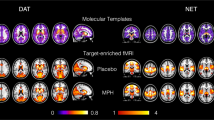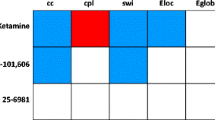Abstract
Rationale
The N-methyl-d-aspartate receptor (NMDAR) antagonist ketamine is known to have not only a rapid antidepressant effect but also dissociative side effects. Traxoprodil and lanicemine, also NMDA antagonists, are candidate antidepressant drugs with fewer side effects.
Objectives
In order to understand their mechanism of action, we investigated the acute effects of traxoprodil and lanicemine on brain connectivity using resting-state functional magnetic resonance imaging (rs-fMRI).
Methods
Functional connectivity (FC) alterations were examined using interregional correlation networks. Graph theoretical methods were used for whole brain network analysis. As interest in NMDAR antagonists as potential antidepressants was triggered by the antidepressant effect of ketamine, results were compared to previous findings from our ketamine studies.
Results
Similar to ketamine but to a smaller extent, traxoprodil increased hippocampal-prefrontal (Hc-PFC) coupling. Unlike ketamine, traxoprodil decreased connectivity within the PFC. Lanicemine had no effect on these properties. The improvement of Hc-PFC coupling corresponds well to clinical result, showing ketamine to have a greater antidepressant effect than traxoprodil, while lanicemine has a weak and transient effect. Connectivity changes overlapping between the drugs as well as alterations of local network properties occurred mostly in reward-related regions.
Conclusion
The antidepressant effect of NMDA antagonists appears to be associated with enhanced Hc-PFC coupling. The effects on local network properties and regional connectivity suggest that improvement of reward processing might also be important for understanding the mechanisms underlying the antidepressant effects of these drugs.






Similar content being viewed by others

References
Artigas F, Schenker E, Celada P, Spedding M, Lladó-Pelfort L, Jurado N, Núñez M, Santana N, Troyano-Rodriguez E, Riga MS, van den Munkhof H, Castañé A, Shaban H, Jay TM, Tripathi A, Godsil BP, Sebban C, Mariani J, Faure P, Takkilah S, Hughes ZA, Siok CJ, Hajos M, Wicke K, Gass N, Weber-Fahr W, Sartorius A, Becker R, Didriksen M, Bastlund JF, Tricklebank M, Risterucci C, Meyer-Lindenberg A, Schwarz AJ (2017) Defining the brain circuits involved in psychiatric disorders: IMI-NEWMEDS. Nat Rev Drug Discov 16:1–2. https://doi.org/10.1038/nrd.2016.205
Becker R, Braun U, Schwarz AJ, Gass N, Schweiger JI, Weber-Fahr W, Schenker E, Spedding M, Clemm von Hohenberg C, Risterucci C, Zang Z, Grimm O, Tost H, Sartorius A, Meyer-Lindenberg A (2016) Species-conserved reconfigurations of brain network topology induced by ketamine. Transl Psychiatry 6:e786. https://doi.org/10.1038/tp.2016.53
Berman RM, Cappiello A, Anand A, Oren DA, Heninger GR, Charney DS, Krystal JH (2000) Antidepressant effects of ketamine in depressed patients. Biol Psychiatry 47:351–354. https://doi.org/10.1016/S0006-3223(99)00230-9
Braun U, Muldoon SF, Bassett DS (2015) On human brain networks in health and disease. Curr Opin Neurol 22:1–9. https://doi.org/10.1002/9780470015902.a0025783
Burrows AM, Ravin PD, Novak P, Peters ML, Dessureau B, Swearer J, Pilitsis JG (2012) Limbic and motor function comparison of deep brain stimulation of the zona incerta and subthalamic nucleus. Neurosurgery 70:125–130; discussion 130-121. https://doi.org/10.1227/NEU.0b013e318232fdac
Croy I, Hummel T (2017) Olfaction as a marker for depression. J Neurol 264:631–638. https://doi.org/10.1007/s00415-016-8227-8
de Oliveira AR, Colombo AC, Muthuraju S, Almada RC, Brandao ML (2014) Dopamine D2-like receptors modulate unconditioned fear: role of the inferior colliculus. PLoS One 9:e104228. https://doi.org/10.1371/journal.pone.0104228
Fitzgerald BJ, Richardson K, Wesson DW (2014) Olfactory tubercle stimulation alters odor preference behavior and recruits forebrain reward and motivational centers. Front Behav Neurosci 8:81. https://doi.org/10.3389/fnbeh.2014.00081
Gass N, Becker R, Sack M, Schwarz AJ, Reinwald J, Cosa-Linan A, Zheng L, von Hohenberg CC, Inta D, Meyer-Lindenberg A, Weber-Fahr W, Gass P, Sartorius A (2018) Antagonism at the NR2B subunit of NMDA receptors induces increased connectivity of the prefrontal and subcortical regions regulating reward behavior. Psychopharmacology 235:1055–1068. https://doi.org/10.1007/s00213-017-4823-2
Gass N, Schwarz AJ, Sartorius A, Schenker E, Risterucci C, Spedding M, Zheng L, Meyer-Lindenberg A, Weber-Fahr W (2014) Sub-anesthetic ketamine modulates intrinsic BOLD connectivity within the hippocampal-prefrontal circuit in the rat. Neuropsychopharmacology 39:895–906. https://doi.org/10.1038/npp.2013.290
Geng H, Wu F, Kong L, Tang Y, Zhou Q, Chang M, Zhou Y, Jiang X, Li S, Wang F (2016) Disrupted structural and functional connectivity in prefrontal-hippocampus circuitry in first-episode medication-naive adolescent depression. PLoS One 11:e0148345. https://doi.org/10.1371/journal.pone.0148345
Glover GH, Li T-Q, Ress D (2000) Image-based method for retrospective correction of physiological motion effects in fMRI: RETROICOR. Magn Reson Med 44:162–167. https://doi.org/10.1002/1522-2594(200007)44:1<162::AID-MRM23>3.0.CO;2-E
Godsil BP, Kiss JP, Spedding M, Jay TM (2013) The hippocampal-prefrontal pathway: the weak link in psychiatric disorders? Eur Neuropsychopharmacol 23:1165–1181. https://doi.org/10.1016/j.euroneuro.2012.10.018
Gong L, Yin Y, He C, Ye Q, Bai F, Yuan Y, Zhang H, Lv L, Zhang H, Xie C, Zhang Z (2017) Disrupted reward circuits is associated with cognitive deficits and depression severity in major depressive disorder. J Psychiatr Res 84:9–17. https://doi.org/10.1016/j.jpsychires.2016.09.016
Gong Q, He Y (2015) Depression, neuroimaging and connectomics: a selective overview. Biol Psychiatry 77:223–235. https://doi.org/10.1016/j.biopsych.2014.08.009
Grimm O, Gass N, Weber-Fahr W, Sartorius A, Schenker E, Spedding M, Risterucci C, Schweiger JI, Böhringer A, Zang Z, Tost H, Schwarz AJ, Meyer-Lindenberg A (2015) Acute ketamine challenge increases resting state prefrontal-hippocampal connectivity in both humans and rats. Psychopharmacology 232:4231–4241. https://doi.org/10.1007/s00213-015-4022-y
Gudayol-Ferré E, Peró-Cebollero M, González-Garrido AA, Guàrdia-Olmos J (2015) Changes in brain connectivity related to the treatment of depression measured through fMRI: a systematic review. Front Hum Neurosci 9:582. https://doi.org/10.3389/fnhum.2015.00582
Guo J, Zhou D, Grimm SW, Bui KH (2015) Pharmacokinetics, metabolism and excretion of [14C]-lanicemine (AZD6765), a novel low-trapping N-methyl-d-aspartic acid receptor channel blocker, in healthy subjects. Xenobiotica 45:244–255. https://doi.org/10.3109/00498254.2014.966175
Hikosaka O, Bromberg-Martin E, Hong S, Matsumoto M (2008) New insights on the subcortical representation of reward. Curr Opin Neurobiol 18:203–208. https://doi.org/10.1016/j.conb.2008.07.002
Hwang JW, Xin SC, Ou YM, Zhang WY, Liang YL, Chen J, Yang XQ, Chen XY, Guo TW, Yang XJ, Ma WH, Li J, Zhao BC, Tu Y, Kong J (2016) Enhanced default mode network connectivity with ventral striatum in subthreshold depression individuals. J Psychiatr Res 76:111–120. https://doi.org/10.1016/j.jpsychires.2016.02.005
Hyvärinen A, Karhunen J, Oja E (2001) Independent component analysis. John Wiley & Sons
Johnson K, Shah A, Jaw-Tsai S, Baxter J, Prakash C (2003) Metabolism, pharmacokinetics, and excretion of a highly selective N-methyl-d-aspartate receptor antagonist, traxoprodil, in human cytochrome P450 2D6 extensive and poor metabolizers. Drug Metab Dispos 31:76
Kelly RE Jr, Alexopoulos GS, Wang Z, Gunning FM, Murphy CF, Morimoto SS, Kanellopoulos D, Jia Z, Lim KO, Hoptman MJ (2010) Visual inspection of independent components: defining a procedure for artifact removal from fMRI data. J Neurosci Methods 189:233–245. https://doi.org/10.1016/j.jneumeth.2010.03.028
Luckenbaugh DA, Niciu MJ, Ionescu DF, Nolan NM, Richards EM, Brutsche NE, Guevara S, Zarate CA (2014) Do the dissociative side effects of ketamine mediate its antidepressant effects? J Affect Disord 159:56–61. https://doi.org/10.1016/j.jad.2014.02.017
Mealing GAR, Lanthorn TH, Murray CL, Small DL, Morley P (1999) Differences in degree of trapping of low-affinity uncompetitive N-methyl-d-aspartic acid receptor antagonists with similar kinetics of. Block J Pharmacol Exp Ther 288:204–210
Meibohm B, Derendorf H (1997) Basic concepts of pharmacokinetic/pharmacodynamic (PK/PD) modelling. Int J Clin Pharmacol Ther 35:401–413
Miller OH, Yang L, Wang CC, Hargroder EA, Zhang Y, Delpire E, Hall BJ (2014) GluN2B-containing NMDA receptors regulate depression-like behavior and are critical for the rapid antidepressant actions of ketamine. Elife 3:e03581. https://doi.org/10.7554/eLife.03581
Munoz C, Rocher C, Spedding M, Jay TM (2004) Acute stress-induced changes in hippocampal/prefrontal circuits in rats: effects of. Antidepressants Cerebral Cortex 14:224–229. https://doi.org/10.1093/cercor/bhg122
Nasrallah FA, Tan J, Chuang K-H (2012) Pharmacological modulation of functional connectivity: α2-adrenergic receptor agonist alters synchrony but not neural activation. NeuroImage 60:436–446. https://doi.org/10.1016/j.neuroimage.2011.12.026
Posner J, Cha J, Wang Z, Talati A, Warner V, Gerber A, Peterson BS, Weissman M (2015) Increased default mode network connectivity in individuals at high familial risk for depression. Neuropsychopharmacology 41:1759–1767. https://doi.org/10.1038/npp.2015.342
Preskorn SH, Baker B, Kolluri S, Menniti FS, Krams M, Landen JW (2008) An innovative design to establish proof of concept of the antidepressant effects of the NR2B subunit selective N-methyl-D-aspartate antagonist, CP-101,606, in patients with treatment-refractory major depressive disorder. J Clin Psychopharmacol 28:631–637. https://doi.org/10.1097/JCP.0b013e31818a6cea
Pruim RH, Mennes M, van Rooij D, Llera A, Buitelaar JK, Beckmann CF (2015) ICA-AROMA: a robust ICA-based strategy for removing motion artifacts from fMRI data. Neuroimage 112:267–277. https://doi.org/10.1016/j.neuroimage.2015.02.064
Qu Y, Yang C, Ren Q, Ma M, Dong C, Hashimoto K (2017) Comparison of (R)-ketamine and lanicemine on depression-like phenotype and abnormal composition of gut microbiota in a social defeat stress model. Sci Rep 7:15725. https://doi.org/10.1038/s41598-017-16060-7
Rolls ET (2016) A non-reward attractor theory of depression. Neurosci Biobehav Rev 68:47–58. https://doi.org/10.1016/j.neubiorev.2016.05.007
Rubinov M, Sporns O (2010) Complex network measures of brain connectivity: uses and interpretations. Neuroimage 52:1059–1069. https://doi.org/10.1016/j.neuroimage.2009.10.003
Rubinov M, Sporns O (2011) Weight-conserving characterization of complex functional brain networks. Neuroimage 56:2068–2079. https://doi.org/10.1016/j.neuroimage.2011.03.069
Sampath D, Sathyanesan M, Newton SS (2017) Cognitive dysfunction in major depression and Alzheimer’s disease is associated with hippocampal-prefrontal cortex dysconnectivity. Neuropsychiatr Dis Treat 13:1509–1519. https://doi.org/10.2147/NDT.S136122
Sanacora G, Smith MA, Pathak S, Su HL, Boeijinga PH, McCarthy DJ, Quirk MC (2014) Lanicemine: a low-trapping NMDA channel blocker produces sustained antidepressant efficacy with minimal psychotomimetic adverse effects. Mol Psychiatry 19:978–985. https://doi.org/10.1038/mp.2013.130
Scheinost D, Holmes SE, DellaGioia N, Schleifer C, Matuskey D, Abdallah CG, Hampson M, Krystal JH, Anticevic A, Esterlis I (2018) Multimodal investigation of network level effects using intrinsic functional connectivity, anatomical covariance, and structure-to-function correlations in unmedicated major depressive disorder. Neuropsychopharmacology 43:1119–1127. https://doi.org/10.1038/npp.2017.229
Schwarz AJ, Danckaert A, Reese T, Gozzi A, Paxinos G, Watson C, Merlo-Pich EV, Bifone A (2006) A stereotaxic MRI template set for the rat brain with tissue class distribution maps and co-registered anatomical atlas: application to pharmacological MRI. NeuroImage 32:538–550. https://doi.org/10.1016/j.neuroimage.2006.04.214
Soiza-Reilly M, Commons KG (2011) Glutamatergic drive of the dorsal raphe nucleus. J Chem Neuroanat 41:247–255. https://doi.org/10.1016/j.jchemneu.2011.04.004
Sporns O (2011) Networks of the brain. MIT press,
Tang H, Kukral D, Li YW, Fronheiser M, Malone H, Pena A, Pieschl R, Sidik K, Tobon G, Chow PL, Bristow LJ, Hayes W, Luo F (2018) Mapping the central effects of (±)-ketamine and traxoprodil using pharmacological magnetic resonance imaging in awake rats. J Psychopharmacol 32:146–155. https://doi.org/10.1177/0269881117746901
Taylor TJ, Diringer K, Russell T, Venkatakrishnan K, Wilner K, Crownover PH, Benincosa LJ, Gibbs MA (2006) Absolute oral bioavailability of traxoprodil in cytochrome P450 2D6 extensive and poor metabolisers. Clin Pharmacokinet 45:989–1001. https://doi.org/10.2165/00003088-200645100-00003
van Buuren M, Gladwin TE, Zandbelt BB, van den Heuvel M, Ramsey NF, Kahn RS, Vink M (2009) Cardiorespiratory effects on default-mode network activity as measured with fMRI. Hum Brain Mapp 30:3031–3042. https://doi.org/10.1002/hbm.20729
Villar MJ, Vitale ML, Hokfelt T, Verhofstad AA (1988) Dorsal raphe serotoninergic branching neurons projecting both to the lateral geniculate body and superior colliculus: a combined retrograde tracing-immunohistochemical study in the rat. J Comp Neurol 277:126–140. https://doi.org/10.1002/cne.902770109
Vollenweider FX, Kometer M (2010) The neurobiology of psychedelic drugs: implications for the treatment of mood disorders. Nat Rev Neurosci 11:642–651
Vuilleumier P (2015) Affective and motivational control of vision. Curr Opin Neurol 28:29–35. https://doi.org/10.1097/WCO.0000000000000159
Williams KA, Magnuson M, Majeed W, LaConte SM, Peltier SJ, Hu X, Keilholz SD (2010) Comparison of alpha-chloralose, medetomidine and isoflurane anesthesia for functional connectivity mapping in the rat. Magn Reson Imaging 28:995–1003. https://doi.org/10.1016/j.mri.2010.03.007
Zarate CA Jr, Singh JB, Carlson PJ et al (2006) A randomized trial of an n-methyl-d-aspartate antagonist in treatment-resistant major depression. Arch Gen Psychiatry 63:856–864. https://doi.org/10.1001/archpsyc.63.8.856
Zarate CA et al (2013) A randomized trial of a low-trapping nonselective N-methyl-D-aspartate channel blocker in major depression. Biol Psychiatry 74:257–264. https://doi.org/10.1016/j.biopsych.2012.10.019
Zhang J, Wang J, Wu Q, Kuang W, Huang X, He Y, Gong Q (2011) Disrupted brain connectivity networks in drug-naive, first-episode major depressive disorder. Biol Psychiatry 70:334–342. https://doi.org/10.1016/j.biopsych.2011.05.018
Acknowledgments
We thank Claudia Falfan-Melgoza and Felix Hörner for excellent technical assistance.
Funding
This study was supported by an unrestricted grant of Boehringer Ingelheim Pharma, Ingelheim, Germany.
It was partially supported by grants from the German Research Foundation (Deutsche Forschungsgemeinschaft): DFG GA 2109/2-1 to N.G. and DFG SA 1869/11-2 and SA 1869/14–1 to A.S.
Author information
Authors and Affiliations
Corresponding author
Ethics declarations
Conflict of interest
LK, BS, SS, DS, and CDC are employees of Boehringer Ingelheim Pharma, Ingelheim, Germany. All other authors state no conflict of interest.
Additional information
Publisher’s note
Springer Nature remains neutral with regard to jurisdictional claims in published maps and institutional affiliations.
Electronic supplementary material
ESM 1
(PDF 350 kb)
Rights and permissions
About this article
Cite this article
Becker, R., Gass, N., Kußmaul, L. et al. NMDA receptor antagonists traxoprodil and lanicemine improve hippocampal-prefrontal coupling and reward-related networks in rats. Psychopharmacology 236, 3451–3463 (2019). https://doi.org/10.1007/s00213-019-05310-3
Received:
Accepted:
Published:
Issue Date:
DOI: https://doi.org/10.1007/s00213-019-05310-3



